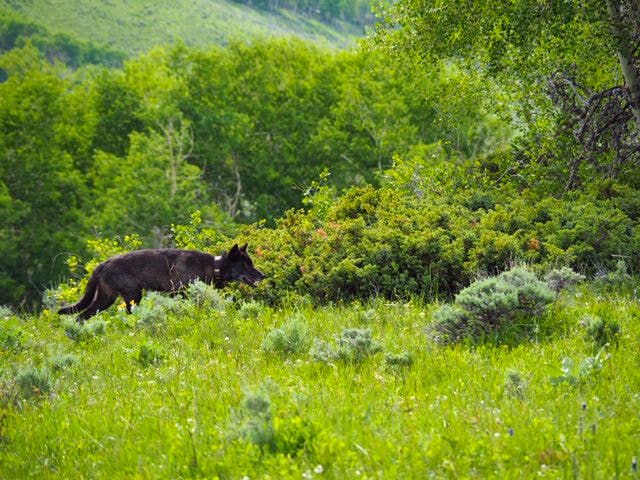Update January 6, 2020: Colorado Secretary of State Jena Griswold announced today that Initiative 107, which would require Colorado Parks and Wildlife to develop a plan to reintroduce wolves to Colorado by December 2023, has received 139,333 valid signatures, surpassing the minimum 124,632 valid signatures needed to appear on the 2020 ballot.
More than 70 years after the last wolf in Colorado was killed, Colorado remains wolf-less. But that may change if the voters of the state have their say.
On Tuesday, December 10th, Defenders of Wildlife assisted the Rocky Mountain Wolf Action Fund with the delivery of over 211,000 signatures of Colorado voters to the Secretary of State in Denver, Colorado to place a referendum on the 2020 election ballot asking voters if wolf reintroduction is right for Colorado.
This represents a historic opportunity for Colorado to restore our natural balance and right a historic wrong, but some have wondered, “Why reintroduction?” Wolves reside in the neighboring state of Wyoming, they can cover great distances, and dispersing lone wolves looking to mate often migrate far outside the home range of their natal pack. In the 25 years (an exciting anniversary!) since the restoration of wolves in the Northern Rockies of Wyoming, Idaho and Montana, wolves have expanded into the western states of Washington, Oregon, and even California. Why, then, do wolves remain absent from Colorado? With no shortage of ideal habitat in the Southern Rockies Ecoregion, there’s plenty of space for wolves. In terms of prey availability, Colorado has the largest elk herd in the lower 48 states, with roughly 400,000 deer in addition to the estimated 280,000 elk. Perhaps most importantly, consistent polling shows that Coloradans want wolves. By any measure, western Colorado is ideal habitat for wolves. So, where are they?
Two significant barriers largely prevent wolf range expansion from Wyoming to Colorado. Throughout 85% of the state, there exists what is called the “Predator Zone,” an area designated by the state legislature in which there are no regulations on the hunting of wolves. Wolves can be killed in any number, at any time, and by any means. According to the 2018 Wyoming Wolf Report, 42 wolves were killed in the Predator Zone of Wyoming that year. Because the southern portion of the state is dominated by the Red Desert, over 9,000mi2 of arid desert which sits on the Wyoming/Colorado border, the habitat is much less suitable for wolves. Between surviving the rifle scopes and the low-quality wolf habitat, it’s highly unlikely that a breeding population of wolves will successfully cross into Colorado on their own.
There have been a few noteworthy lone-wolf exceptions. In 2004, a wolf was found just outside of Idaho Springs, Colorado along the I-70 corridor. Unfortunately, that wolf was discovered as the victim of a car collision. The story repeated in 2007, 2009, and in 2015, with rare sightings met with wolf fatalities. While these individuals prove that wolves are exceptional in their ability to survive tremendous obstacles, the likelihood of individuals traveling to Colorado, finding mates, and establishing a viable population on their own is bleak. Despite this reality, some believe wolves should recolonize as opposed to being reintroduced. In 2005, a member of the 2004 Colorado Wolf Working Group was quoted as stating “I’m convinced in 10 years, we will have wolves living in Colorado.” Fourteen years later, we still hear the same arguments. What you won’t hear, however, is the song of the wolf in the Centennial State.
Without a reintroduction, wolves are unlikely to establish a viable population on their own in Colorado, which brings us to the next sticking point: shouldn’t it be the state biologists who determine wolf reintroductions? Colorado Parks and Wildlife is staffed by many experts and is indeed the logical state agency to oversee a reintroduction. Our plan to restore wolves to Colorado acknowledges that, with the ballot question directing the parks and wildlife commission to conduct and oversee the process of reintroduction, should the measure pass. Whether wolf restoration to Colorado would be good for the ecological balance of our state is not in serious question. What is asked of Colorado voters is whether or not this is an effort the commission should begin. As it stands now, the state legislature has prevented species reintroductions to Colorado without its permission, and wolf opponents simply have too much control in state politics.
For decades, Coloradans have voiced their support for wolf restoration, yet the political process has marred attempts to bring those desires to fruition. With the submission of over 211,000 signatures, this effort represents the strong value Coloradans place in their wild spaces. This moment represents six months of work gathering signatures across the state, thanks in no small part to a dedicated team of volunteers. For weeks on end, supporters of wolf restoration have taken on the task of hitting the streets to reach out to the public and start a conversation about the future of Colorado’s wild spaces and restoring our natural balance.
Within the next few weeks, we will know the results of that effort when the Secretary of State confirms the ballot proposal for 2020. Once accepted, the 2020 election will be the first time voters can decide through a process of direct democracy on the issue of wildlife reintroduction, marking what will be a historic occasion in an effort to restore wolves along the entire spine of the Rockies from Alaska to Mexico by restoring this iconic species to the missing piece of the connectivity puzzle: Colorado.
With over 66% of the state in support, and a litany of science boasting the ecological value of apex predators, we are excited to return to the wolf to his historic range. Join us as we answer the call of democracy, support strong science, champion the restoration of imperiled wildlife, and leave to future generations an ecologically sound world.












Follow Defenders of Wildlife
facebook bluesky twitter instagram youtube tiktok threads linkedin